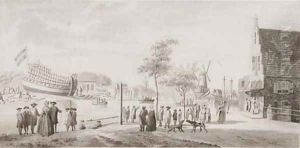Hendrik Tavenier Paintings
Hendrik Tavenier was a Dutch artist known for his watercolor paintings and etchings. Born on August 22, 1734, in Rotterdam, Netherlands, Tavenier became especially recognized for his detailed landscapes and cityscapes, which often featured Dutch scenes and landmarks. His work provides a valuable historical record of the Netherlands during the 18th century, capturing the appearance of towns and countryside prior to the modern era.
Tavenier was trained in the arts in his hometown of Rotterdam, and his style was influenced by the Dutch artistic traditions of the time, which placed a great emphasis on realism and attention to detail. He worked primarily as a watercolorist and draughtsman, and he was also skilled in the art of etching. His works were appreciated for their precision and the quality of light and shadow, which he rendered with meticulous care.
Throughout his career, Tavenier remained active in the art community in the Netherlands. He traveled within the country, drawing and painting various Dutch cities and landscapes, which made him a significant contributor to the topographical recording of the era. His works serve as historical documents, showing the architecture and urban planning of Dutch cities, as well as the rural landscapes of the period.
Hendrik Tavenier passed away on January 26, 1807, in Amsterdam. While he may not be as well-known as some of his contemporaries, his works are still studied and appreciated by art historians and collectors who have an interest in Dutch art and the historical portrayal of the Netherlands. His legacy is preserved through his contributions to the visual documentation of Dutch landscapes and urban scenes from the 18th century.
